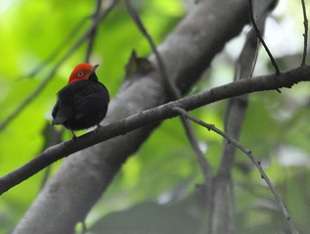Acrobatic birds aren't as energetic as they look

In research published this week in Proceedings of the Royal Society B scientists have found that the acrobatic courtship displays of male golden-collared manakins are less energetically costly than they appear.
The scientists behind the study published today were intrigued by the energetic displays of the golden-collared manakin. Their acrobatics raised the heart rate of the birds to rates which can briefly exceeds 1300 beats per minute. This increased rate suggests the courtship performances require a high energy investment. However, animals in the tropics tend to live slow paced lives with low metabolic rates expending less energy per day than counterparts from more temperate habitats. A team of scientists lead by Julia Barske from the University of California set out to investigate how golden-collared manakins keep up their acrobatic displays- do they live faster-paced, higher-energy lives than other tropical creatures or are their displays less energetically costly than they seem?
To determine the energy expended by golden-collared manakins the team of scientists measured the birds' heart rates. The researchers captured eight manakins and attached miniature transmitters with electrodes inserted under the birds' skin. The transmitters, which fall off harmlessly after 14 days, sent the scientists data about the heart rates of the golden-collared manakins throughout the study whilst they were at rest and whilst they performed courtship displays. The team also measured the oxygen consumption of some of the birds to help them work out that heart rate and metabolism in this particular species are linearly related.
During courtship performances the team found the heart rates of the manikins they monitored rose from around 450 (±15) beats per minute to 1017 (±28). These performances each last around 9.5 seconds but the number of performances each bird produces per day varied from 1.6 to 140. The team used this information to calculate how much energy manikins expended on their acrobatic dances, concluding that their performances require on average 0.5 kJ per day, amounting to around 5.2% of daily energy expenditure for the most active birds and just 0.1% for the least active.
Despite their exuberant courtship rituals manikins expend very little of their daily energy on romancing potential partners with acrobatic displays. The team suggest this could explain why the manakins' breeding season, which sometimes lasts seven months, can continue for so long whilst the manakins maintain their slow pace of life, typical to animals in the tropics
More information: J. Barske, L. Fusani, M. Wikelski, N. Y. Feng, M. Santos, and B. A. Schlinger. "Energetics of the acrobatic courtship in male golden-collared manakins (Manacus vitellinus)." Proc. R. Soc. B February 7, 2014 281 1776 20132482; DOI: 10.1098/rspb.2013.2482 1471-2954
Journal information: Proceedings of the Royal Society B
Provided by The Royal Society




















